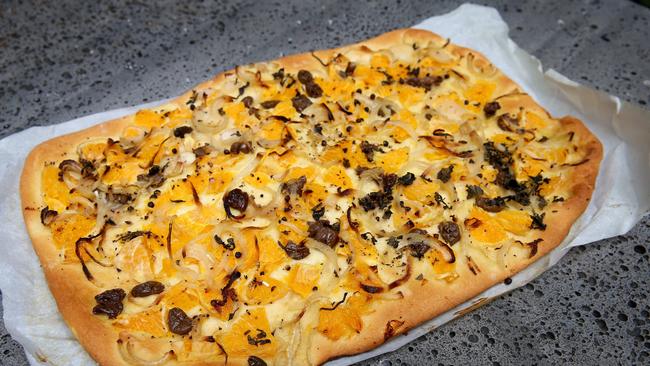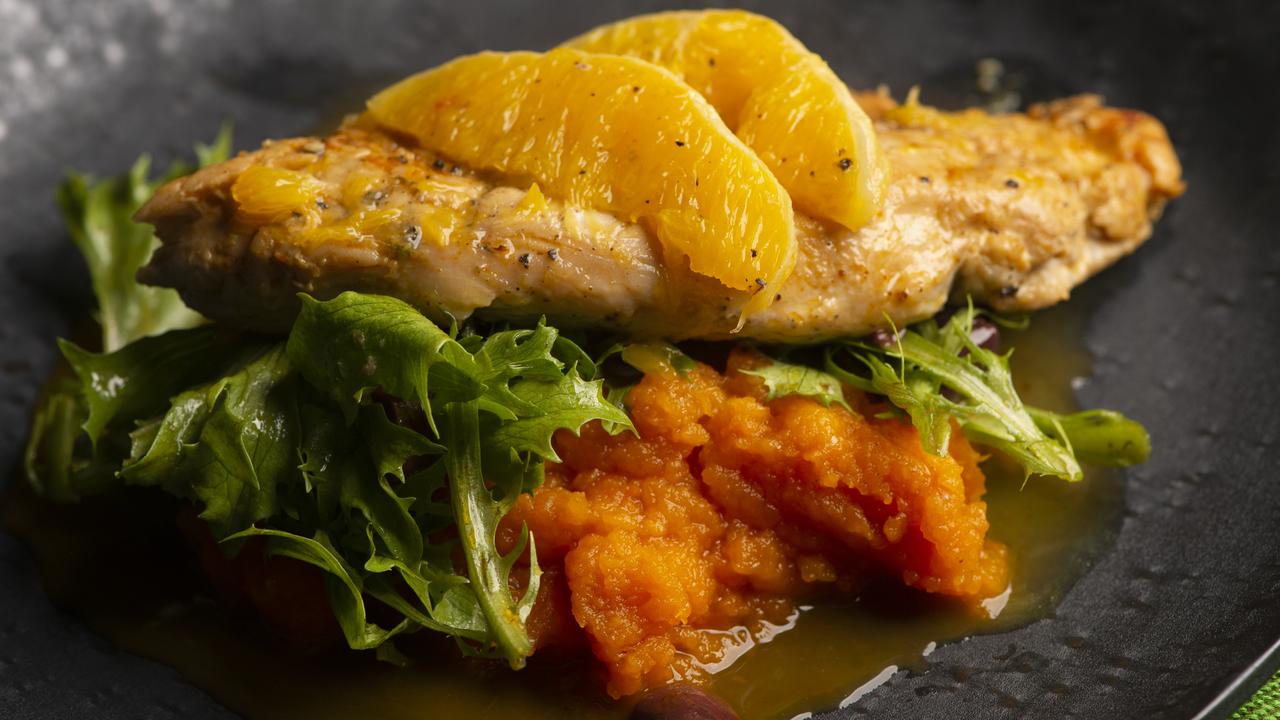Focaccia with orange and olives recipe
WHILE there are plenty of options for most of us to buy ready-made bread, I find it one of the most satisfying of recipes to prepare from scratch.

WHILE there are plenty of options for most of us to buy ready-made bread, I find it one of the most satisfying of recipes to prepare from scratch.
Focaccia is a good place to start, and this orange infused recipe gives the finished bread a special taste, great for your Melbourne Cup picnic.
FOCACCIA WITH ORANGE AND OLIVES
Sweet, tangy and salty, this focaccia is hard to stop eating.
Depending on the size of your oranges, you may not use all of them, and though it may look like a lot of onion, don’t worry: It shrinks when baked.
Serves 16
1½ tbsp sugar
2½ tsp active dry yeast (1x7g sachet)
2 oranges
2 tsp salt
500g plain flour, plus more for kneading
5 tbsp extra-virgin olive oil
1 onion, halved, very thinly sliced
¼ cup pitted black olives, such as kalamatas, slivered lengthwise
Flaky sea salt
Freshly ground black pepper
2 tsp chopped fresh oregano
In a small bowl, combine the sugar, yeast and ¼ cup warm water (ideally, use a thermometer and heat the water to about 32C).
Let the mixture stand until the yeast dissolves and the mixture is foamy, about 15 minutes.
Meanwhile, use a microplane or fine grater to remove 1½ tbsp zest from the oranges, and toss the zest with the salt in a small bowl.
In a large bowl, combine 470g of the flour with the salt and zest, using your fingers to make sure the zest is well distributed with no clumps.
Make a well in the centre, add the yeast mixture, 2 tbsp of the oil, and 1 cup warm water, and stir with a wooden spoon until a rough dough forms.
Oil a large, clean mixing bowl with about 1tbsp of the oil.
Turn the dough on to a lightly floured work surface and knead in the remaining flour.
Continue kneading until the dough is soft and smooth, shape it into a ball, and transfer it to the prepared bowl.
Turn the dough over in the bowl to thoroughly coat with oil.
Cover the bowl with plastic wrap and a kitchen towel, and let rise until doubled in size.
Peel and slice the oranges, and then cut each slice into 4 to 6 pieces.
Position a rack in the centre of the oven, and heat to 200C.
Roll the dough out on a piece of baking-paper sized for a large baking tray until it is almost the size of the baking paper.
Transfer on the baking paper to a large rimmed baking tray, fitting it to fill, and using wet fingertips, make indentations across the surface.
Brush all over with 2 tbsp of oil, letting the oil pool in the indentations.
Scatter the orange pieces and olives over the surface of the dough and gently press them into the dough.
Spread the onion slices evenly over the dough and gently press in.
Sprinkle all over with flaky salt, a little black pepper and the oregano.
Bake until risen and golden on top and bottom, 25 to 35 minutes.
(Areas around the orange pieces will remain light.)
Slide a metal spatula under the focaccia and transfer it to a rack.
Let cool briefly before cutting and serving.
MORE FROM JEREMY VINCENT:
HOW TO COOK PRAWNS TO PERFECTION
WORKING WITH YEAST
MAKE sure you have the liquid temperature correct when using yeast. Use a thermometer to measure the water temperature accurately. Any thermometer will work as long as it measures accurately up to 60C. The trick is, the water has to be warm enough to activate the yeast, but not so hot that it kills it.
THERE’S no action! So your water is the perfect temperature and still there is no action from the yeast. Is it still active? Is it fresh? Always check the used-by date. Before you start your recipe, it pays to test it to see if it is still active. To do so, dissolve 1 tsp sugar in ½ cup warm water (around 32C). Sprinkle the water with 1 sachet active dry yeast and stir. Allow it to stand for 10 minutes. If it gets bubbly and foamy it is still active and you can continue with your recipe. Store your active dry yeast in the refrigerator — even before you open it.
DON’T rush the rising time. When making yeast bread, the kneaded dough must have time to rise. During rising, the yeast ferments or eats the sugar and develops the dough. Rising improves the flavour and texture of the bread. Many factors, including the recipe, room temperature, and humidity, will determine how long it takes for your dough to rise. Yeast dough is considered “ripe” when it has doubled in size.


